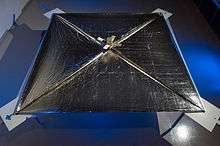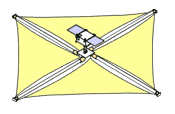LightSail 2
| Names | LightSail-1[1] |
|---|---|
| Mission type | Technology Demonstration |
| Operator | The Planetary Society |
| Website |
sail |
| Start of mission | |
| Launch date | March 2017[2] |
| Rocket | Falcon Heavy |
| Launch site | LC-39A, Kennedy Space Center |
| Contractor | SpaceX |
LightSail 2 is a project to build a solar sail spacecraft, scheduled for launch in March 2017 and developed by The Planetary Society, a global non-profit organization devoted to space exploration.[3] The kite-shaped spacecraft, which was announced in 2009, will have a total sail area of 32 square meters (340 sq ft), and will be fitted with guidance and diagnostic electronics.
On 20 May 2015 a smaller technology demonstrator, LightSail 1 (formerly called LightSail-A[1]), was launched and deployed its solar sail on 7 June 2015. If the 2017 mission is successful, two more solar sails, LightSail 3 and LightSail 4, will be built.[4]
History

In 2005, The Planetary Society attempted to send its first solar sail, Cosmos 1, into orbit, but the Russian Volna launch vehicle failed to reach orbit.[5] In 2009, the Society took over NASA's NanoSail-D project, which they later renamed LightSail.[6] Nanosail-D had failed to attain orbit in August 2008 due to the failure of its Falcon 1 launch vehicle. (A backup, NanoSail-D2, was successfully deployed in early 2011.)
In November 2009, the Society announced in Washington D.C. that it would build and launch LightSail 2, a larger version to be placed at a higher orbit.[6] By 2011, the project had passed its critical design review, which was conducted by a team including JPL project veterans Bud Schurmeier, Glenn Cunningham, and Viktor Kerzhanovich, as well as Dave Bearden of Aerospace Corporation.[4] The estimated cost of LightSail 2 was US$1.8 million, which was raised from membership dues and private sources. The prototype spacecraft LightSail 1 (or LightSail-A) was built in San Luis Obispo by Stellar Exploration Inc.[5]
In March 2016, The Planetary Society announced they decided to use the convention on naming the spacecraft with the program name followed by a sequential number; the test flight or LightSail-A, became LightSail 1, and the upcoming larger spacecraft is now called LightSail 2.[1]
Design
As a solar sail, LightSail 2's propulsion is dependent on solar radiation alone. Solar photons will exert radiation pressure on the sail, producing a small degree of acceleration. Thus, the solar sail will be propelled by pressure from sunlight itself, and not by the charged particles of the solar wind.[7] Although the acceleration is expected to be slow, it will be continuous, permitting LightSail 2 to reach relatively high speeds over time.[5][6]

Structure
LightSail 2 has four triangular sails, which combine to form a rectangular-shaped surface. The spacecraft will have a 3U CubeSat (3-litre volume) format, and will unfold to its full size upon deployment at its designated orbit altitude of 500 miles (800 km).[8] The sails are made of Mylar, a reflective polyester film, and they have a total area of 32 m2, which would make the craft easily visible to naked-eye observers on Earth.[9]
LightSail 2's modular design will be based on a modular three-unit CubeSat, a small satellite format created for university-level space projects. One CubeSat module or unit will carry the cameras, sensors and control systems, while the other two units will contain and deploy the solar sails.[8]
Mission goals
LightSail 2's goal is to test whether solar sails are a viable form of spacecraft propulsion, although deployment and operation of a solar sail has already been demonstrated by the Japanese interplanetary spacecraft IKAROS, launched in 2010. The LightSail team will measure whether there is any increase in LightSail 2's orbital speed once the spacecraft deploys its sail at an altitude of 500 miles (800 km).[8] The Planetary Society originally hoped to launch LightSail 2 in 2012,[10] but in 2014 announced that it was scheduled for launch in April 2016.[3] The LightSail 2 mission is now scheduled to launch in March 2017 on the first SpaceX Falcon Heavy launch carrying the STP-2 payload for the U.S. Air Force.[11]
LightSail 1 test flight
A preliminary technology demonstrator spacecraft, LightSail 1 (formerly LightSail-A[1]), was launched at 15:05 UTC on 20 May 2015 from Cape Canaveral Air Force Station, Florida.[12][13][14] This launch delivered the satellite to an orbit low enough that atmospheric drag brought LightSail 1 down seven days after sail deployment,[15] but it allowed a full checkout of the satellite's systems in advance of the main mission at a higher orbit.[16]
Two days after the launch, however, the spacecraft suffered a software malfunction which made it unable to deploy the solar sail or to communicate.[15] On 31 May 2015, The Planetary Society reported having regained contact with LightSail 1,[17][18] and two days later they were still trying to upload a software fix in preparation to its solar sail deployment.[19] Due to communication limitations imposed by the tumbling attitude of the spacecraft, efforts to patch the software were abandoned by the end of that day.[20] After the solar panels were deployed on 3 June 2015, communications with the spacecraft were lost once more on 4 June. In this case, a fault with the battery system was suspected, as it had not been charging after solar panel deployment.[21] Contact was then reestablished on 6 June,[22] and the sail deployment was initiated on 7 June.[23] At a conference on 10 June 2015, after photos of deployment were downloaded, the test flight was declared a success.[24] The spacecraft reentered the atmosphere on 14 June 2015, ending the test flight.[25][26]
Future projects
If LightSail 2 is successful, The Planetary Society will execute two more solar sail projects with more complex goals. LightSail 3 goal will be to collect scientific data and improve solar sailing control. LightSail 4 goal would be to travel to the L1 Lagrangian point. There, it would be used to detect geomagnetic storms on the Sun, which can damage power and communication systems on Earth and orbiting spacecraft. Such detection will provide earlier warnings of potential power failures.[6][8]
See also
- IKAROS, a Japanese solar sail, launched in May 2010
- NanoSail-D2, the successor to NanoSail-D, launched in November 2010
- Near-Earth Asteroid Scout, a solar sail planned to launch in 2018
- Sunjammer, a solar sail that was cancelled before launch in 2014
References
- 1 2 3 4 Davis, Jason (1 March 2016). "Meet LightSail 2, The Planetary Society's new solar sailing CubeSat". The Planetary Society. Retrieved 2016-03-01.
- ↑ Stephen Clark [StephenClark1] (2016-03-01). "Payload officials with satellites aboard STP-2 mission (second Falcon Heavy) say launch has slipped from Oct. 2016 to March 2017." (Tweet) – via Twitter.
- 1 2 Davis, Jason (10 July 2014). "LightSail update: Launch dates". The Planetary Society. Retrieved 10 July 2014.
- 1 2 Louis D. Friedman (June 25, 2010). "LightSail-1 Passes Critical Design Review". The Planetary Society.
- 1 2 3 Antczak, John (November 9, 2009). "After letdown, solar-sail project rises again". MSNBC. Associated Press.
- 1 2 3 4 Dennis Overbye (November 9, 2009). "Setting Sail Into Space, Propelled by Sunshine". The New York Times.
- ↑ "Planetary Society To Sail Again With LightSail". Space Travel blog. November 10, 2009.
- 1 2 3 4 "LightSail-1". The Planetary Society.
- ↑ "LightSail Has a Launch Date!". The Planetary Society.
- ↑ "NASA to test new solar sail technology". Universe Today. 13 October 2011. Retrieved 2011-10-29.
- ↑ Nye, Bill. Kickstart LightSail. Event occurs at 3:20. Retrieved 15 May 2015.
- ↑ "Mission Control Center". The Planetary Society. Retrieved 2015-05-22.
- ↑ Wall, Mike (10 May 2015). "Tiny Solar Sail 'Cubesat' Launching with X-37B Space Plane on Wednesday". Space.com. Retrieved 2015-05-20.
- ↑ Davis, Jason (April 13, 2015). "LightSail Launch Delayed until at least May 20". The Planetary Society.
- 1 2 Wall, Mike (27 May 2015). "LightSail Solar Sail Test Flight Stalled by Software Glitch". Space.com. Retrieved 2015-05-29.
- ↑ Davis, Jason (January 26, 2015). "It's Official: LightSail Test Flight Scheduled for May 2015". The Planetary Society.
- ↑ Fingas, John. "LightSail solar spacecraft gets back in touch with its ground crew". Engadget. Retrieved 2015-05-31.
- ↑ "Bill Nye's LightSail spacecraft is back in touch with Earth after rebooting itself". The Verge. 31 May 2015. Retrieved 2015-05-31.
- ↑ Davis, Jason (31 May 2015). "LightSail Team Prepares for Sail Deployment". Planetary Society. Retrieved 2015-06-02.
- ↑ Davis, Jason (31 May 2015). "LightSail Team Prepares for Sail Deployment". Planetary Society.
- ↑ Davis, Jason (4 June 2015). "LightSail Falls Silent; Battery Glitch Suspected". Planetary Society.
- ↑ "LightSail Drama Continues as Spacecraft Wakes for Second Time". The Planetary Society. 2015-06-06. Retrieved 2015-06-06.
- ↑ Deployment! LightSail Boom Motor Whirrs to Life. 7 June 2015
- ↑ LightSail Test Mission Declared Success; First Image Complete. 9 June 2015.
- ↑ LightSail Solar Sail Ends Test Flight with Fall Back to Earth. Leonard David, Space.com. 18 June 2015.
- ↑ Molczan, Ted (2015-06-14). "LightSail-A: Post-Sail Deployment Orbital Elements". Retrieved 2015-06-15.